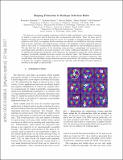| dc.contributor.author | Leal Machado, Francisco | |
| dc.contributor.author | Rivera, Nicholas H. | |
| dc.contributor.author | Buljan, Hrvoje | |
| dc.contributor.author | Soljacic, Marin | |
| dc.contributor.author | Kaminer, Ido Efraim | |
| dc.date.accessioned | 2022-07-15T12:54:56Z | |
| dc.date.available | 2021-10-27T20:29:33Z | |
| dc.date.available | 2022-07-15T12:54:56Z | |
| dc.date.issued | 2018 | |
| dc.identifier.uri | https://hdl.handle.net/1721.1/135835.2 | |
| dc.description.abstract | © 2018 American Chemical Society. The discovery of orbital angular momentum (OAM) in light established a new degree of freedom by which to control not only its flow but also its interaction with matter. Here, we show that by shaping extremely subwavelength polariton modes, for example by imbuing plasmon and phonon polaritons with OAM, we engineer which transitions are allowed or forbidden in electronic systems such as atoms, molecules, and artificial atoms. Crucial to the feasibility of these engineered selection rules is the access to conventionally forbidden transitions afforded by subwavelength polaritons. We also find that the position of the absorbing atom provides a surprisingly rich parameter for controlling which absorption processes dominate over others. Additional tunability can be achieved by altering the polaritonic properties of the substrate, for example by tuning the carrier density in graphene, potentially enabling electronic control over selection rules. Our findings are best suited to OAM-carrying polaritonic modes that can be created in graphene, monolayer conductors, thin metallic films, and thin films of polar dielectrics such as boron nitride. By building on these findings we foresee the complete engineering of spectroscopic selection rules through the many degrees of freedom in the shape of optical fields. | en_US |
| dc.language.iso | en | |
| dc.publisher | American Chemical Society (ACS) | en_US |
| dc.relation.isversionof | 10.1021/ACSPHOTONICS.8B00325 | en_US |
| dc.rights | Article is made available in accordance with the publisher's policy and may be subject to US copyright law. Please refer to the publisher's site for terms of use. | en_US |
| dc.source | arXiv | en_US |
| dc.title | Shaping Polaritons to Reshape Selection Rules | en_US |
| dc.type | Article | en_US |
| dc.contributor.department | Massachusetts Institute of Technology. Department of Physics | en_US |
| dc.contributor.department | Massachusetts Institute of Technology. Research Laboratory of Electronics | en_US |
| dc.relation.journal | ACS Photonics | en_US |
| dc.eprint.version | Original manuscript | en_US |
| dc.type.uri | http://purl.org/eprint/type/JournalArticle | en_US |
| eprint.status | http://purl.org/eprint/status/NonPeerReviewed | en_US |
| dc.date.updated | 2019-06-10T11:41:45Z | |
| dspace.orderedauthors | Machado, F; Rivera, N; Buljan, H; Soljačić, M; Kaminer, I | en_US |
| dspace.date.submission | 2019-06-10T11:41:48Z | |
| mit.journal.volume | 5 | en_US |
| mit.journal.issue | 8 | en_US |
| mit.metadata.status | Publication Information Needed | en_US |
